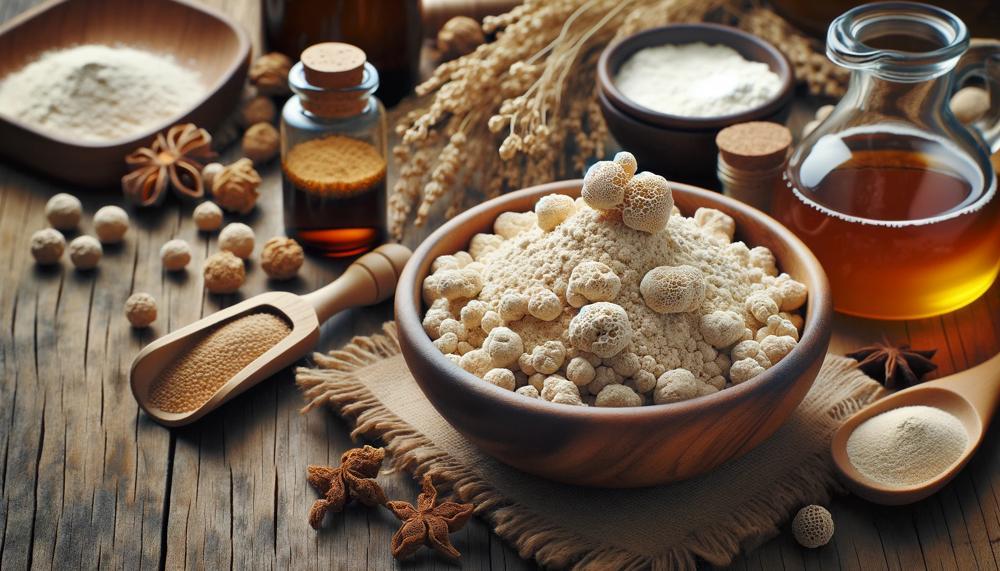Many bakers are unsure whether to refrigerate their dry yeast or simply keep it at room temperature. So, what’s the best approach? Let’s dive into the facts and explore the benefits of each storage method.
So, does dry yeast need to be refrigerated?
A pantry or refrigerator are good places to keep unopened dried yeast since they are cold and dry. Heat, moisture, or oxygen exposure may all reduce the activity of yeast. Yeast should be refrigerated, sealed container kept out of drafts, once it is opened. If kept refrigerated, yeast will keep for three to four months; if frozen, it will keep for six months.
Yeast cells remain fresher for longer when they are frozen because they are in a condition of suspension. Before using frozen yeast, let it come back to room temperature.
Contents
- 1 Storing Dry Yeast at Room Temperature
- 2 Storing Dry Yeast in the Refrigerator
- 3 Shelf Life of Dry Yeast
- 4 Proper Storage of Opened Dry Yeast
- 5 Freezing Dry Yeast
- 6 Signs of Improperly Stored Dry Yeast
- 7 Best Environment for Yeast Storage
- 8 Proofing Yeast Before Baking
- 9 Tips for Proper Yeast Storage
- 10 Conclusion
Key Takeaways:
- Dry yeast can be stored at room temperature or in the refrigerator.
- Storing dry yeast at room temperature is suitable for short-term usage.
- Refrigerating dry yeast can extend its viability and maintain its effectiveness.
- Labeling and proper storage in an airtight container are crucial for maintaining yeast quality.
- Proofing yeast before using it in a recipe ensures its activation and viability.
Storing Dry Yeast at Room Temperature
When it comes to storing dry yeast, there is a range of options available. Some individuals prefer to store their dry yeast at room temperature, particularly if they plan to use it within a few months. It is important, however, to consider the impact of room temperature storage on the viability and effectiveness of the yeast.
Dry yeast stored at room temperature within a cool and dry environment can maintain its viability and remain suitable for use. Ensure that the storage location is free from extreme temperature fluctuations, as this can negatively impact the yeast’s functionality. By providing a stable and temperate atmosphere, you can help ensure the continued effectiveness of your dry yeast.
“Maintaining a cool, dry place for storing dry yeast at room temperature can contribute to its viability and make it viable for a few months.”
However, it is important to note that storing dry yeast at room temperature for extended periods may result in a decreased viability and effectiveness over time. If you anticipate that you will not be using the yeast within a few months or are unsure about the specific timeline, it may be advisable to consider alternative storage methods such as refrigeration or freezing for prolonged viability.
Benefits of Storing Dry Yeast at Room Temperature:
- Convenient access without the need for refrigeration or defrosting
- Potential cost savings compared to refrigeration or freezing methods
- Ease of use with immediate availability for baking
While storing dry yeast at room temperature can be a viable option, it is crucial to monitor the yeast’s condition regularly and consider alternative storage methods if extended viability is desired. By understanding the impact of room temperature storage on dry yeast and its overall viability, you can make an informed decision about the best storage method for your particular needs.
Storing Dry Yeast in the Refrigerator
Storing dry yeast in the refrigerator can significantly extend its viability and maintain its effectiveness, especially if you don’t plan on using it within a short period. Refrigeration provides a cool and controlled environment that helps prevent moisture absorption, ensuring the yeast stays fresh for a more extended period.
When storing dry yeast in the refrigerator, it’s important to transfer it to an airtight container or keep it in its original packaging. This will help seal out any air and moisture, preserving the quality of the yeast. Ensure that the container is tightly closed to prevent any unwanted exposure to moisture or odors in the refrigerator.
Before using refrigerated dry yeast in your recipe, it’s crucial to allow it to come to room temperature. This will ensure that the yeast activates properly and doesn’t affect the dough’s temperature when added to the mix.
Allowing the yeast to equilibrate with the room temperature ingredients will provide the best results in your baking endeavors.
Shelf Life of Dry Yeast
When it comes to dry yeast, understanding its shelf life is crucial for maintaining its freshness and effectiveness in baking. The shelf life of dry yeast can vary depending on the brand and storage conditions.
Unopened dry yeast typically has a shelf life of about two years. It’s important to check the expiration date on the package when purchasing dry yeast and choose the freshest product available. This ensures that you are starting with yeast that is at its peak performance.
Once you’ve opened a package of dry yeast, it’s essential to store it properly to maximize its longevity. Generally, opened dry yeast can last for around four months when stored in the refrigerator and up to six months when placed in the freezer. These lower temperatures help slow down the yeast’s activity and preserve its viability for a more extended period.
However, it’s important to note that freezing is not suitable for fresh yeast, as it can significantly affect its quality and performance. Fresh yeast has a much shorter shelf life of about two weeks and should be used promptly after purchase.
To summarize, the shelf life of dry yeast can be extended by following proper storage guidelines. Refrigeration or freezing can help maintain the yeast’s viability, enabling you to enjoy baking with reliable results for an extended period. It’s always wise to check the expiration date and use the freshest yeast available for optimal results in your culinary creations.
| Storage Method | Shelf Life |
|---|---|
| Unopened dry yeast | About two years |
| Opened dry yeast (Refrigerated) | Around four months |
| Opened dry yeast (Frozen) | Up to six months |
| Fresh yeast | About two weeks |
Proper Storage of Opened Dry Yeast
When it comes to storing opened dry yeast, the key is to keep it in an airtight container to prevent exposure to air and moisture. By doing so, you can maintain the viability of the yeast and prevent spoilage, ensuring that it remains fresh for future use.
One method of achieving this is to fold over the top of the yeast package and seal it with tape. This provides a temporary barrier against air and moisture. However, for optimal storage, it is recommended to transfer the yeast to a sealed zip-top bag or airtight glass jar.
Labeling the container with the date it was opened and the use-by date is also crucial. This helps you keep track of the yeast’s freshness and ensures you use it in a timely manner. You can use a permanent marker or adhesive label to clearly indicate this information.
By storing your opened dry yeast in an airtight container and labeling it appropriately, you can prolong its shelf life and maintain its effectiveness. This will allow you to confidently use the yeast in your baking endeavors, knowing it will contribute to delicious, flavorful results.
Freezing Dry Yeast
Freezing dry yeast can be an effective method to extend its shelf life and maintain its viability.
When you freeze dry yeast, it places the yeast cells in a state of suspension, preserving their effectiveness until you’re ready to use them.
It’s important to note that freezing dry yeast is suitable, but the same cannot be said for fresh yeast. Freezing fresh yeast may result in some yeast die-off and a decrease in performance.
If you choose to freeze bread dough that contains dry yeast, it’s generally acceptable. However, be aware that the freezing process may lead to a minor loss in yeast viability.
Before incorporating frozen yeast into a recipe, it’s recommended to allow it to come to room temperature. This allows the yeast to fully activate and ensures optimal performance in your baking endeavors.
| Benefits of Freezing Dry Yeast | Considerations for Freezing |
|---|---|
|
|
Signs of Improperly Stored Dry Yeast

Dry yeast that has been improperly stored may display signs of spoilage or ineffective performance. These signs can include clumpy granules and yeast that does not flow smoothly when poured. When you notice these indicators, it’s essential to address the issue before using the yeast in your recipes.
Improper storage can lead to clumpy granules in dry yeast. Instead of having smooth and free-flowing particles, improperly stored yeast might form lumps or clusters. This could be a result of moisture absorption or exposure to extreme temperatures during storage.
Moisture is one of the main culprits behind clumpy granules in dry yeast. High humidity or improper sealing can cause moisture to seep into the packaging, leading to the formation of clumps. Always make sure to store yeast in a cool and dry place, away from moisture sources like sinks or stovetops.
In addition to clumping, improperly stored dry yeast may also lose its viability, resulting in ineffective performance during the baking process. If the yeast fails to dissolve or activate as expected, it may be a sign of improper storage.
Testing the Viability of Dry Yeast
To determine the freshness and viability of improperly stored dry yeast, you can perform a simple test. Dissolve a small amount of the yeast in warm water and add a pinch of sugar. Allow the mixture to sit for several minutes and observe for any signs of activity.
If the yeast is still viable, it will begin to froth or foam, indicating that the yeast is active and suitable for use. On the other hand, if there is no frothing or the yeast remains dormant, it is likely that the yeast has lost its effectiveness and should be replaced with fresh yeast for optimal baking results.
Being able to identify the signs of improperly stored dry yeast is crucial in maintaining the quality and effectiveness of your yeast for successful baking. By storing yeast correctly and testing its viability when in doubt, you can ensure that your yeast contributes to the perfect rise and flavor of your homemade breads and pastries.
Best Environment for Yeast Storage
When it comes to yeast storage, finding the best environment is key to maintaining its shelf life and viability. Yeast is a living organism, and factors such as temperature and moisture can greatly impact its effectiveness. To ensure optimal yeast storage, it is essential to consider the following:
- Cool and Dry Place: Storing yeast in a cool and dry place is crucial. Excessive heat can accelerate yeast activity, leading to a decrease in its shelf life. Conversely, excess moisture can cause clumping and promote the growth of mold. Therefore, storing yeast in a cool and dry place is ideal to maintain its viability.
- Airtight Container: Protecting yeast from air and moisture is essential to prevent spoilage. By storing yeast in an airtight container, you can limit its exposure to these harmful elements. This will help maintain its quality and extend its shelf life.
- Mold and Spoilage: Yeast is sensitive to mold and spoilage caused by excess moisture. Therefore, it is crucial to store yeast in a way that prevents moisture from reaching it. Keeping yeast in an airtight container away from wet surfaces will help protect it from mold and spoilage.
- Temperature and Humidity: Both temperature and humidity play a significant role in yeast storage. Yeast thrives in temperatures ranging from 70 to 90 degrees Fahrenheit (21 to 32 degrees Celsius). It’s best to store yeast in an area with steady temperature and humidity levels. Avoid storing yeast in areas prone to high humidity, such as near the stove or dishwasher.
By following these guidelines, you can ensure that your yeast stays fresh and effective for all your baking needs.
Proofing Yeast Before Baking
Proofing yeast before using it in a recipe is an essential step to activate and ensure the viability of the yeast. It involves combining the yeast with warm water and a small amount of sugar, allowing it to bloom and become frothy. This process reveals the yeast’s activity level and confirms its suitability for baking.
During proofing, the yeast feeds on the sugar, producing carbon dioxide gas, which creates the bubbles and froth. This reaction indicates that the yeast is alive and active, ready to leaven the dough and provide the desired rise. The frothy appearance demonstrates the yeast’s ability to produce carbon dioxide, a critical factor for achieving light and airy baked goods.
If the yeast does not show signs of activity during the proofing process, such as failing to bubble or become frothy within the expected timeframe, it may indicate that the yeast is no longer viable. In such cases, it is recommended to use a fresh batch of yeast to ensure optimal baking results.
Proofing yeast before baking serves as a reliable test to verify its effectiveness and determine if it will contribute to a successful outcome.
Tips for Proper Yeast Storage
To ensure optimal longevity and effectiveness of your yeast, it is crucial to follow these expert tips for proper yeast storage:
- Use an Airtight Container: Store yeast in an airtight container to prevent exposure to air and moisture. This will help maintain its quality and keep it fresh for longer.
- Consider Refrigeration or Freezing: For extended shelf life, consider refrigerating or freezing your yeast. Both options can help preserve its viability and effectiveness.
- Label Opened Yeast Containers: Properly label opened yeast containers with the date of opening and the use-by date. This will help you keep track of its freshness and ensure timely usage.
- Follow Manufacturer’s Instructions: Always follow the manufacturer’s instructions for yeast storage, including recommended storage conditions and shelf life. This information can be found on the packaging or the manufacturer’s website.
By implementing these yeast storage tips, you can maximize the viability and effectiveness of your yeast, resulting in successful baking endeavors. Taking care of your yeast and storing it properly is essential for achieving optimal baking results.
Conclusion
In summary, the storage of dry yeast is a matter of personal preference and specific brand recommendations. Whether you choose to refrigerate or store it at room temperature, the key is to protect the yeast from exposure to air, moisture, and extreme temperatures.
To maintain the viability and extend the shelf life of dry yeast, store it in an airtight container. This will help preserve its quality and effectiveness, regardless of where you choose to store it.
Remember to check the expiration date on the packaging and follow the manufacturer’s storage guidelines. Using yeast within the recommended timeframe will ensure optimal baking results. Experimentation may be necessary to find the best storage method for your specific needs.
By following proper storage practices and taking care of your dry yeast, you can enjoy its benefits for an extended period and achieve excellent results in your baking endeavors.
Source Links
- https://www.homebrewersassociation.org/forum/index.php?topic=22171.0
- https://www.bobsredmill.com/blog/healthy-living/how-to-store-active-dry-yeast/
- https://www.southernliving.com/food/bread/how-to-store-yeast




